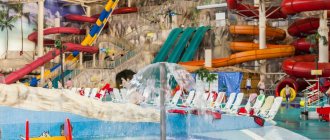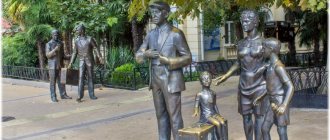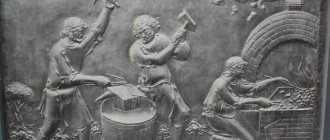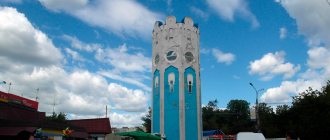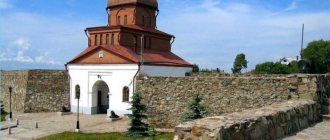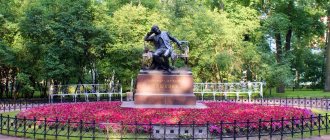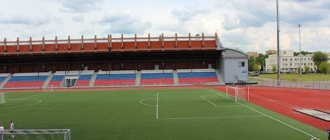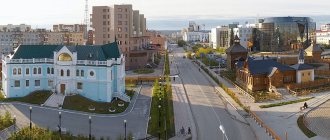One of the most famous monuments of Yekaterinburg is the monument to the founding fathers of the city Vasily Nikitich Tatishchev and Georg Wilhelm (Vilim Ivanovich) de Gennin. The monument is located in the historical center of the Ural capital, near the city dam. Two famous figures are depicted standing side by side (in full height), the inscription on the monument reads “To the glorious sons of Russia V.N. Tatishchev and V.I. de Gennin, Ekaterinburg grateful 1998.”
© Irina Egorova
Near the cultural site there are other attractions - Labor Square with a fountain, the chapel of the Holy Great Martyr Catherine, the Water Tower, the Museum of Nature, the Sevastyanov House, the Museum of Stone-Cutting Art, etc. The monument to Tatishchev and de Gennin is included in the list of objects of the tourist route - “Red Line” .
Near the base of the monument there are granite steps and a platform, which were chosen by urban skaters. City holidays, rallies, concerts and other events are also held on the square in front of the sculptural structure.
Monuments to political and military figures
The lion's share of attractions in cities are traditionally occupied by monuments to famous people who left their mark on the history of Russia and changed the course of events in the country.
Thus, the monument to Zhukov in Yekaterinburg, located on Lenin Avenue, 71, was designed in honor of the 50th anniversary of Victory in the Great Patriotic War by sculptor Konstantin Grunberg. The location of the monument was not chosen by chance - behind it is the headquarters of the Volga-Ural Military District, in which Georgy Konstantinovich held command. Citizens and tourists invariably bring flowers to the sculpture.
An interesting place is the monument to Yeltsin in Yekaterinburg on Boris Yeltsin Street. Not only because it is a 10-meter obelisk, with a bas-relief of the first president carved inside, but also because since 2011 (the date of the opening of the architectural structure in honor of the 80th anniversary of Boris Nikolayevich) the memorial has been desecrated by vandals several times - the stele causes a storm of negativity as among party citizens and simply among residents.
The wreckage of autocracy
Writer, politician and concerned citizen Anton Bakov proposed giving Yekaterinburg the status of the imperial capital of Russia. With his support, IMC publishes a historical column in which we study the past of our city.
Monuments to emperors in non-capital cities are a sign of special gratitude from residents. Pre-revolutionary Yekaterinburg was poor in monuments, but they were created not by decree from above, but on the initiative of the townspeople, often with funds raised through joint efforts. In the revolutionary year, the overthrow of the monarchy in a city with the potential name Tsareubiysk was accompanied by the overthrow of bronze emperors from their pedestals. But in the last two decades, with the rehabilitation of the city’s monarchical past and the formation of a “royal” identity, the bronze fragments of autocracy are gradually being glued together.
Monuments for the exhibition
As now, more than a hundred years ago, a large-scale event could become a significant reason for transforming the city. "Expo" of 1887, the Siberian-Ural Scientific and Industrial Exhibition lasted four months and attracted businessmen, industrialists, artists, scientists - more than 80,000 Russian and foreign visitors to the Urals. Especially for this event, the ambitious head of the Yekaterinburg-1 railway station, Dmitry Lobanov, organized a park near the dam on the side of the city pond, which was a novelty by the standards of an industrial city of the 19th century. The territory was practically bare, so a small square significantly improved the appearance of the city. The park area was laid out on the spot where the first factory work began in the 18th century by decree of Peter I and Catherine I. In 1886, on the territory of Plotinny (also called Zheleznodorozhny) square, the first bust monuments to the first Russian emperors were erected in Yekaterinburg. They were located on marble pedestals and were surrounded by a wooden fence. According to local historians, white double asters were planted near the bust of Peter, and white petunias were planted near Catherine. The pedestals were engraved with “To Emperor Peter I, the founder of mining in the Urals: 1723” and “To Empress Catherine I, the founder of the city of Yekaterinburg: 1723.”
Monuments to monarchs stood on Plotinka until 1917. As far as we know, they were “overthrown” from their pedestals by anarchist soldiers of one of the Siberian regiments fleeing from the front of the First World War. According to one of the most common versions, soldiers drowned the busts of monarchs under the dam. Russian geologist Modest Kler in 1945 proposed his geophysical methods for searching and raising monuments from the pond, but the busts were never found.
A marble pedestal has been preserved from the monument to Peter I, on which a bust of A.M. Gorky, placing it on the left bank of the pond. It did not stand on the embankment of the city pond for long: due to the fragility of the material, the bust collapsed. Now in their places are busts of the Ural writers Pavel Bazhov (installed in 1958, sculptor M. Manizer) and Dmitry Mamin-Sibiryak (installed in 1987, sculptor A. Antonov).
Return to the park
After the collapse of the USSR, attention to pre-revolutionary history and to the founders of the city especially increased. In the early 1990s, a graduate of the Ural State Academy of Arts, sculptor Gennady Chekhomov proposed to restore the historical monument to Peter I. The bust, restored from photographs, was cast at the Kasli Metallurgical Plant from cast iron, and the preserved pedestal was used as a base. The official opening of the monument took place in 1992 in the courtyard of the Museum of Architecture and Industrial Technology of the Urals (now the Museum of Architecture and Design of the Urals State Academy of Arts). On the historical pedestal there is an image of the coat of arms and the inscription: “To Emperor Peter I, the founder of the mining business in the Urals.” Below, Roman letters and numbers indicate the founding date of the city of Yekaterinburg: MDCCXXIII (1723). But even after restoration, the monument moved around the park.
“In connection with the reconstruction of the Museum of Architecture and Design (as part of which the courtyard space where the monument to Peter I stood was blocked), they decided to move the monument to a new location,” says Elena Shtubova, a researcher at the Museum of Architecture and Design. – In 2013, the monument to Peter I experienced another, third birth. Architect S.A. Dektyarev and sculptor Yu.V. Krylov developed a project for installing a monument in the Historical Square in an updated form (the base of the old marble pedestal was replaced by a new granite one). On November 15, 2013, the monument to Peter I was moved to the site in front of the building of the former forest drying shop of the Yekaterinburg Mechanical Factory; it took a central place in the exhibition of large-sized equipment from Ural factories.
Gratitude to the Tsar-Liberator
If Peter I and his wife Catherine were directly related to Yekaterinburg and were its founders, then Alexander II was not directly connected with the history of the city. Only once, as a crown prince, he visited Yekaterinburg. However, the glory of Alexander II as a tsar-liberator was all-Russian. The main reason for gratitude to the tsar was the peasant reform of 1861, because of which the tsar became deeply respected by the people. There are several places in Yekaterinburg associated with his name. The first is the Alexander Almshouse on Vojvodina Street. It was erected in honor of the “salvation” of the sovereign after an unsuccessful attempt on his life in 1877.
Another object is the Alexander Nevsky Chapel on the Bread Market (now the territory of the Arboretum), which was erected in 1881 to mark the twentieth anniversary of the abolition of serfdom. Similar chapels can be found in many cities of Russia.
But judging by the fact that the chapels were erected quite quickly and everywhere, they were built with government money. The fact that the people were sincerely grateful to Alexander II was proved by the full-length monument to the sovereign on the main square of Yekaterinburg. It was installed using public money, which was collected by the entire city for 25 years.
“The abolition of serfdom can be approached in different ways,” notes Evgeny Burdenkov, head of the scientific and information center of the Museum of the History of Yekaterinburg. – For some, the reform of 1861 was a blessing, but for others it was a worsening situation. For example, the peasants of the black earth strip, along with freedom, received only a small piece of land, from which it was impossible to feed themselves. Therefore, they were forced to rent land from the landowner, which became a new form of enslavement with a system of redemption payments. But for the workers it was a great boon. The enslavement of people in factories was harsh. As soon as freedom was declared, the peasants from . After 1861, the Mint, the Mechanical Factory, and the Elizavetinsky Plant were closed, and many refused to work at state-owned enterprises. But many alternatives appeared - private plants and factories, where working conditions were better. Therefore, it was in the Urals that the abolition of serfdom was viewed very positively.
The collection of money for the monument to the Tsar-Liberator began in 1886, five years after his death. The idea of immortalizing Emperor Alexander II was submitted by the doorman of the district court, the former serf Olympius Klevakin. The first project was submitted to the City Duma for consideration in the spring of 1887. Fundraising among the Yekaterinburg merchants was continued by the merchant E.A. Telegin, and by the end of the year the special construction committee established by the Duma had the sum of 2 thousand rubles.
However, they collected money in several approaches. Only by 1895, at the intersection of Uktusskaya (8 March) and Main Avenue (Lenin Avenue) streets, a granite pedestal with steps and four lanterns on poles appeared. But it took another 11 years for the monument to the monarch to appear on the pedestal.
The design of the monument to the merchant A.P. Kozhevnikov, approved by the provincial construction committee, was considered by the ministry in 1894 to be “inappropriate for its high purpose” and demanded that it be redone. As a result, the Duma decided to stage the exact work of the sculptor M.P. Popov, author of the monument to Alexander II in the Catherine Hall of the Moscow District Court. In 1900, the residents of Yekaterinburg bought M.P. from the widow. Popova the right to re-casting.
In 1903, the figure was cast from cast iron at the Kusinsky plant in the Southern Urals, but its quality again did not suit the city authorities. Then the workers of the Kasli plant got down to business, they cast a new version of the monument to the Tsar-Liberator, and on October 19, 1906 it was presented to the townspeople.
The monument depicted Emperor Alexander II in full height, in a general’s uniform, facing east. In his right hand he held a scroll with the words "February 19, 1861." On the pedestal of the monument there was an inscription: “To the Tsar the Liberator in memory of February 19, 1861 from the city society and mining workers. Cross yourself with the sign of the cross, Orthodox people, and call upon us God’s blessing on your free labor.”
At the time of its installation, the monument acquired additional significance. By 1906, rulers in Russia had changed twice. It seems that it was no accident that the monument was erected precisely after the intensification of revolutionary processes in the Urals, exactly a year after the bloody pogrom on Cathedral Square (the square of 1905). Perhaps the installation of the monument on this very day was an attempt to strengthen statehood, consolidate society, and acted as “spiritual bonds.”
“This is not the only example that proves the theory of finding a foothold in turbulent times,” emphasizes Evgeny Burdenkov. – In 1905, construction began on the Cathedral of the Exaltation of the Cross on the territory of the St. Nicholas Monastery in Verkhoturye. The grandiose cathedral, the third largest in Russia, was built by a huge number of pilgrims. This suggests that some kind of plan really existed.
In 1917, the monument to the Tsar-Liberator was thrown off its pedestal. The chaotic revolutionary events of that time were rarely recorded, so all that is known is that the workers and peasants overthrew the monarch during the February Revolution.
After that, many monuments were replaced on the pedestal. On March 10, 1917, a small copy of the American Statue of Liberty was installed on it, a symbol of liberal values. In 1918 it was demolished, and for some time the pedestal was empty. In 1919, the Red Army men placed the head of Karl Marx on it, but later moved it to Voznesenskaya Square. The last monument on the pedestal was “Naked Labor” - a full-length marble figure of a naked man, made by avant-garde sculptor Stepan Erzya. The people were dissatisfied with the image of a naked body in the main square, and soon this monument was also demolished.
The monument to Alexander II was never restored.
Second Alexander II
On the territory of present-day Yekaterinburg there was another monument to Alexander II. The bronze bust was installed a year after the death of the tsar at the Nizhne-Isetsky plant (now Khimmash); before the revolution, its territory was not part of Yekaterinburg. Factory workers were especially grateful to the monarch, since he freed them from compulsory labor. The factory workers themselves raised money for the installation, and on May 12, 1882, the priests of the Church of the Kazan Mother of God solemnly consecrated the bronze bust of the emperor.
Like the “previous emperors,” he also did not survive: according to the now classic scenario, he was thrown from his pedestal by revolutionaries. Later, a plaster bust of Karl Marx was installed there, but it soon crumbled. Then a star was installed on the stele, and in 1969 this obelisk was dedicated to the memory of the orphanages who died during the Great Patriotic War. Since 1987, the Council of Veterans of Uralkhimmash has been caring for the monument.
“Despite the fact that most of the time the monument is dedicated to the deceased children from the orphanage, its double meaning has always been preserved,” recalls Antonina Kubasova, former director of the NIIkhimmash museum. – Soviet factory workers knew the history of their predecessors and how important the Tsar’s manifesto was for the workers of the Nizhne-Isetsky plant.
Revival of the Liberator
In 2007, the Ural blacksmith Alexander Lysyakov was told a legend about how Emperor Alexander II forged a horseshoe and four nails in the forge of the Nizhne-Isetsky plant. According to historians, this is really just a legend, and during his visit to Yekaterinburg in 1837, he was not yet Emperor Alexander II, but only the heir to the throne, Tsarevich Alexander Nikolaevich, and did not visit the Nizhne-Isetsky plant at all.
Alexander Lysyakov became interested in the personality of the emperor, learned about the surviving pedestal and turned to the architect Yuri Krylov with a request to recreate the monument, then thanks to him and the efforts of the students of the architectural academy, they managed to raise money for the bust - about two million rubles. The required amount was collected as quickly as once for the original monument, and in 2009 Alexander Burmistrov from Nizhny Tagil cast a copy of the bronze monument.
To this day, the monument to Alexander has not been erected. Now it is located in the Church of the Kazan Icon of the Mother of God on Khimmash.
“We don’t plan to install a bust in the near future,” says Irina Blinovskikh, the temple’s accountant. – It is shaped specifically to fit the stele on which it stood before, but now it is dedicated to the orphanages. This is not only a legal, but also a moral issue - we are not going to take it away from the Veterans Union. Therefore, the fate of the monument has not yet been decided. Perhaps we will install it on the temple grounds.
The last monument to the last monarch
With the emergence of a new identity for the city of Yekaterinburg as the place of death of the royal family, new objects appear: the last of the erected monuments to the Russian tsars is the monument to Nicholas II and his family on the territory of the Church on the Blood by the sculptor Konstantin Grunberg. It was installed in the year the temple opened - in 2003. The sculpture depicts the royal family moments before the execution.
During the Soviet period, much more monuments appeared in the city, and it would seem that now it is difficult for modest restored busts of emperors to compete with them as attractions of the city. However, attention to the monarchical past is increasing every year - the royal family is canonized, a monarchist party is being created, pre-revolutionary monuments are being restored, and plans are being made to install more grandiose monuments to the founder of the city and his wife. In a word, a favorable environment is now being created for a well-founded rehabilitation of Yekaterinburg’s past, the search for new meanings in it, comparable in significance to those left from the “Sverdlovsk” heritage of the city.
The “History of Yekaterinburg” column is published with the support of Anton Bakov and the project “Ekaterinburg - the Imperial Capital of Russia.”
Photo: Yekaterinburg Museum of Architecture and Design, Museum of the History of Yekaterinburg.
Monuments to movie heroes
The television series “Happy Together” inspired sculptor Viktor Mosielev to create a monument to Gene Bukin. The location of the monument (at 48 Weiner Street) is no coincidence: in the store opposite Gen, according to the story, works as a shoe salesman. The height of the monument is 2.2 meters, and its weight reaches almost half a ton. The opening of the monument took place in 2011, which was attended by the actor who played the role of Bukin, Viktor Loginov.
On Belinsky Street there is a monument to famous book and movie characters - Ostap Bender and Kisa Vorobyaninov. The figures look at each other, while Ostap has an apple in his hand, and Kisa has a pince-nez and a hat. This ensemble is especially popular among city guests.
Monument to Gennady Bukin
Several years ago, the first monument in Russia dedicated to Gennady Bukin, the beloved hero of the comedy serial film “Happy Together,” appeared in Yekaterinburg. A popular shoe seller cast in bronze adorns the pedestrian street of Weiner. The bronze father of the comical family is distinguished by his truly heroic height (more than 2 meters) and decent weight. Bukin, dressed in a rumpled shirt for graduation, is captured in his favorite pose - a lady’s shoe in one hand, and the other hand is habitually tucked under his belt.
Unusual objects
Monuments in Yekaterinburg are not only architectural and historical in nature, but also make people think about their shortcomings and characteristics.
So, on Studencheskaya Street there is a monument to curiosity. The author of the sculpture is Viktor Davydov, who is also a pioneer in Russia in making sculptures in this style. The pedestal consists of a door with a peephole more than 3 meters high and the figures of a man and a woman looking into the hole from different sides.
The art designers decided to make Malysheva Street a place for negotiations, and a hint of this was a monument in the form of a tall kitchen grater. To “grind” questions, benches and lanterns are located nearby, so the flow of people does not stop even at late hours.
Monument to a military signalman
A few years ago, another unusual monument appeared in Yekaterinburg - a sculpture of a military signalman. The author of this miracle, located on the corner of Sheinkman Street, was the local sculptor D.V. Kuklin. What to hide, the bronze sculpture came out bright and very lively. The monument represents a Soviet signalman, kneeling on one knee and diligently trying to establish communication. The soldier holds the field telephone with his left hand. The telephone room is tightly clutched in his right hand. And behind your back you can see a reel with a wound cable. It should be noted that funds for the production of the sculpture were allocated by the company, whose founders were also signalmen in the past. It was they who came up with the idea of using such a monument to honor the memory of an entire era, generation and profession.
Historical monuments in Yekaterinburg
The photo of the “Black Tulip” monument, even through the monitor, evokes irresistible grief and pity for all those killed and injured during the conflict in Afghanistan. It was no coincidence that the monument received its name; this is what the soldiers called the aircraft carrying the bodies of the dead. The sculptural complex is designed in such a way that it resembles an airplane with a passenger sitting inside. Over time, steles with the names of the fallen Ural soldiers in the war in Afghanistan were added to the monument.
Those wishing to honor the memory of the deceased can take public transport to the “Shartashskaya Street” stop and from there exit onto Mamin-Sibiryaka Street.
Many cultural monuments in Yekaterinburg are dedicated to the events of the Great Patriotic War, one of these is the monument dedicated to the warrior-athletes of the Urals, participants in the battles. The sculpture is located on Bolshakova Street, 90. It consists of three figures carved into a single monolith, symbolizing the commander, the orderly and the fighter. The Ural warrior-athletes were trained according to special programs, carried out the most difficult secret tasks, and many gave their lives for their Motherland. Therefore, in 1996, a monument was erected in honor of these brave people.
Monument to Comrade Bender and Kisa Vorobyaninov
Near the building of one of the Yekaterinburg real estate agencies you can see a very original sculptural composition dedicated to the heroes of the legendary film masterpiece “12 Chairs”. Skillfully executed figures of the two greatest schemers not only attract the glances of enthusiastic tourists, but also simply lift the spirits of all residents of the Ural capital. The father of Russian democracy, Kisa Vorobyaninov, traditionally stands with his hand outstretched with his hat towards passers-by, who often toss coins there. A grinning comrade Bender looks at him.
Modern Art
New trends have affected the whole world, including monuments in Yekaterinburg. For example, on Gorky Street there is a monument to a keyboard that is not officially recognized as a landmark. Its location on the city embankment has led to the fact that this site is the site of constant photo sessions for both tourists and ordinary citizens. The keys are made of concrete, and are 16 meters long and 4 meters wide. The designations fully correspond to the real ones. The monument was opened in 2005 according to the design of Anatoly Vyatkin.
Sculptor Sergei Belyaev decided to diversify the monuments in Yekaterinburg with the world's first sculpture dedicated to a bank plastic card. The card itself is quite symbolic; it contains a reference to its ideological parent, science fiction writer Edward Bellam - he was the first to describe the semblance of a modern card in his writings. You can see the monument on Malysheva Street.
Interesting Facts
Historians believe that during their lifetime the founding fathers were not friendly and their contemporaries would be very surprised to see such a monument. In addition, the sculptor depicted Tatishchev and de Gennin as surprisingly similar, although this is not the case. Not even all residents of Yekaterinburg can distinguish them from each other and say exactly which one is which. Adding to the complexity is the fact that the inscriptions under the sculptures are mixed up and do not correspond to reality - William de Gennin is located on the left, he can be recognized by his cocked hat, Vasily Tatishchev stands on the right - he has a wig on his head.
After the famous cartoon was shown, young people began to call the monument “Beavis and Butt-head.”
Panorama of the monument in winter:
Monuments dedicated to celebrities
Michael Jackson received material embodiment in various parts of the world, Yekaterinburg was no exception. On Weiner Street, a 3-meter-tall sculpture adorns the square in front of the shopping center. Townspeople-fans became the organizers of the installation of this monument, which conveys the entire essence of the artist: moonwalk, tilted hat, right hand as if addressing the audience.
The residents of Yekaterinburg, who love the work of The Beatles, also distinguished themselves. On Maxim Gorky Street in 2009, a cast-iron silhouette of the band members appeared mounted into a brick wall. The opening was even attended by the band founded by John Lennon – The Quarrymen.
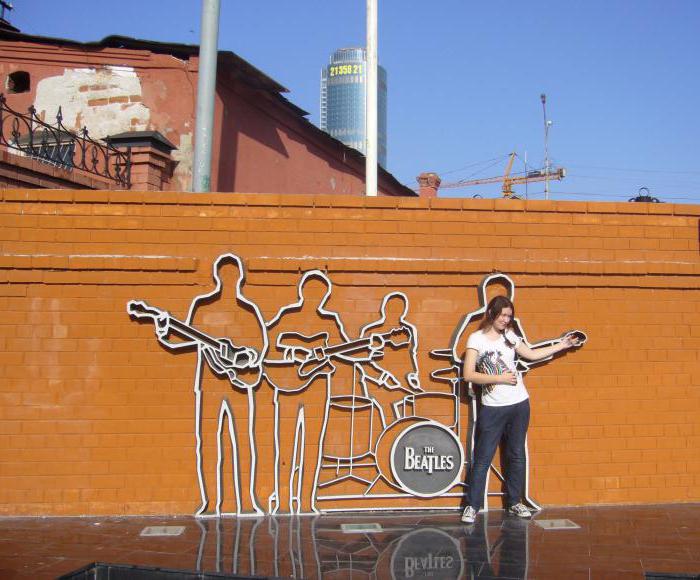
Making monuments is a very complex and painstaking craft. Yekaterinburg boasts truly soulful and touching obelisks, pedestals and memorials. All this is the merit of the most talented sculptors who work on cultural projects not only in Yekaterinburg, but throughout the country. Thanks to their work, the memory of those who are no longer with us is honored.
Historical reference
The engineer, historian and statesman Vasily Tatishchev arrived in the Urals in 1720 with the goal of inspecting the region and identifying sites for the construction of factories. He settled at the Uktus plant, where he founded the Mining Office, which later became the Siberian Higher Mining Authority. Under his leadership, several factories were created, which became city-forming enterprises. In addition, the scientist was actively involved in education, road construction, etc.
His active work did not please the Ural businessman Akinfiy Nikitich Demidov, who accused Tatishchev of embezzlement. An engineer, friend and ally of Peter I, William de Gennin, was sent to the Urals for the investigation, who examined the charges and acquitted Vasily Tatishchev.
Although hostility arose between the figures, in subsequent years they worked fruitfully on the development of the Ural industry. In 1793, the Metallurgical Plant named after Catherine I was opened, which became the city-forming enterprise of Yekaterinburg. Today, in addition to the monument to the founding fathers, in the Ural capital there are streets named after great scientists.
© Anna Kudryavtseva
